1920s FILM highlights~ Murnau's Sunrise and Nosferatu
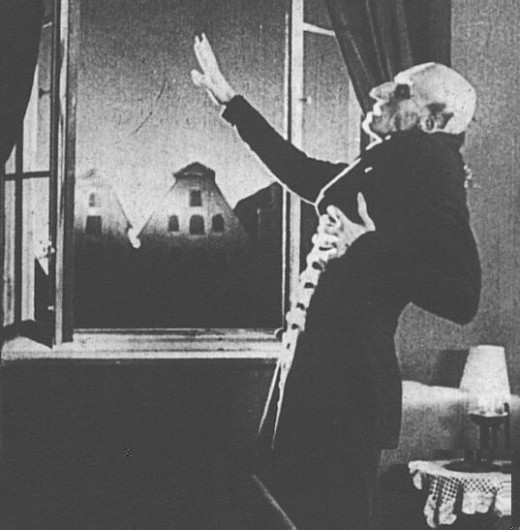
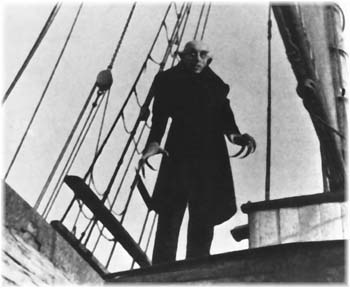
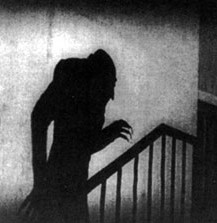
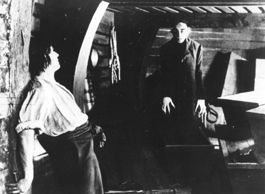
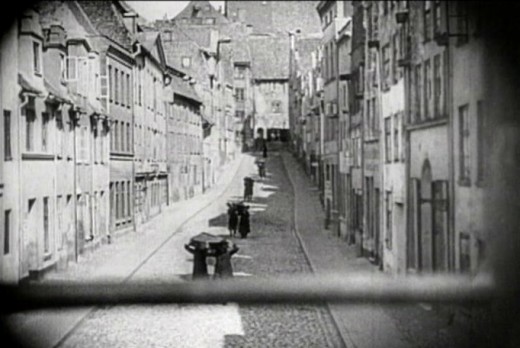

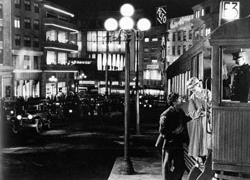
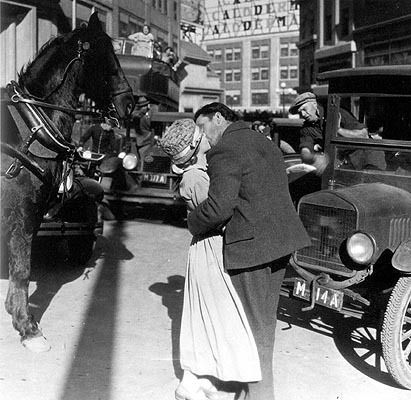
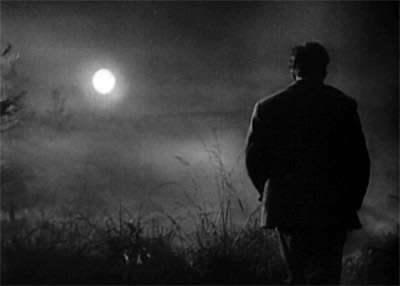
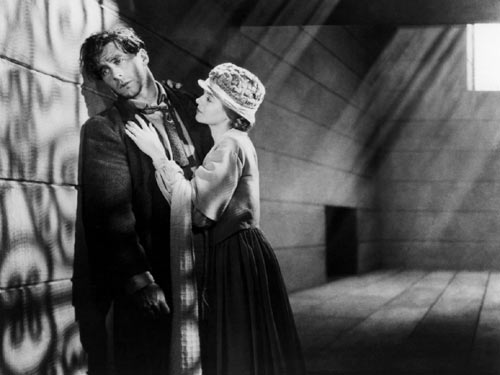
Similarities and Disparities in the Films of Sunrise and Nosferatu
F.W. Murnau, the German film pioneer, helped lead the way to make the motion picture a more powerful medium, and show its potential in exhibiting human qualities, relationships, psychological conflicts, and patterns in society. In Nosferatu (1922), Murnau tells a vampire story that highlights the weaknesses of the human mind, mental delusion, and insanity. In Sunrise(1927), he touches on the marital ties of man and wife, and the presence of temptation that can tear a marriage apart. Using universal emotions and social themes, these films offer glimpses into the human mind and circumstance, while doing so in an entertaining manner. Although these films differ in many aspects, being from broadly different genres, and filmed in different countries, there are numerous parallels that can be drawn.
Both Nosferatu and Sunrise have settings that strongly accentuate the themes that each movie is attempting to convey. With Nosferatu, the use of natural scenes adds so much power to the surreal atmosphere. Murnau attempts to depict an innate darkness to nature and is quite successful in doing so. From the extreme long shots of the Carpathian mountain range to the shadowy forest shots with the lurking phantom, the settings of nature help the viewer to relate with the horrific events. By seeing mountains and trees, the audience can envision the presence of Nosferatu in waking life more vividly, adding a sense of reality to the otherwise imaginary occurrences in Nosferatu. Nature is used to reflect the grim side of reality- this is very evident with the insert of the Venus fly trap, the “vampire of the vegetable kingdom.”
With the film Sunrise, setting is used to easily diversify between the lifestyles of country and city. The country comes off as a place of conventionality and purity, where families live their lives independently of temptation and complication. The city is the fast moving, daring, roller-coaster ride that entices you to pleasure, in exchange for the peace of a pure country life. Although the two settings are close in geographical terms, their atmospheres and circumstances are as distant as heaven and hell, as conflicting as black and white. These settings offer Murnau a great deal of creative room in playing with the psychology of the characters and their alterations of behavior in crossing the lines between country and city.
Scenery is exquisitely used in both of these films; they are adequate in relating the plot and characters to the viewer, but the scenery in Nosferatu is much more entwined into the underlying themes of the film as it is in the film Sunrise. Nosferatu involves more on-the-scene shooting, as nature shots will require; it is also apparently out of the German expressionist era, with the surreal stage sets and props that invoke a sense of a warped hysteria or delusion as you watch the film- these stage sets help the viewer to experience the subconscious tones of insanity. Noticeably different from Nosferatu, Sunrise uses relatively realistic scenery, because the occurrences in the film do not involve any supernatural themes or characters. The city scenery is rather intricate though, and obviously took a great deal of preparation, but mainly remains the backdrop for the unraveling of the plot.
Special effects are more effectively and frequently used in Nosferatu than in the film Sunrise, but both films rely on these effects to strengthen the overall themes. Nosferatu more excessively uses intertitles to display important plotlines and dialogue. More intertitles are needed to clearly convey to the viewer what is going on, wherein Sunrise relies more completely on visuals to show the story. Nosferatu includes multiple uses of irising- it is used properly, but it’s almost as if Murnau uses it just because he can. Sunrise only contains two or three irises, evidence of the dwindling use of irising in motion pictures. Dissolves are also more frequent in the earlier Nosferatu. The truly phenomenal use of dissolution is the scene where Nosferatu literally dissolves from the shot, one of the outstanding trick shots of the film. Viewing these films in succession shows that the pioneer effects of irising, masking, and dissolving were ebbing within the decade of time that these films were shot.
Trick shot imagery is used much more evidently in Nosferatu. The door to Count Orlok’s castle opening of its own accord, the casket cover lifting without a helping hand, and the levitation of Nosferatu- all of these trick images give the viewer the essence of Nosferatu’s inhuman and supernatural qualities. Superimposition is widely used in Nosferatu to exhibit the vampire’s ghostly talent of disappearing and reappearing, but the special effect is also powerfully used in Sunrise. The scene of city life, with three images superimposed at once, offers a clear glimpse into the city’s fast-moving environment. The most effective use of superimposition in Sunrise is the scene in which the woman from the city was layered to appear above the husband; this ingeniously inserted layer represents the woman from the city invading the husband’s conscience, literally a glimpse into his manipulated mind. Her face in the sky reminds the husband of the diabolic scheme to remove the wife from the picture. The insert of the spinning wheel in the city scene is also an example of the powerful tool of special effects, which gives the city a dizzying, mesmerizing, and almost intoxicating presence.
Crosscutting is used strongly in both films. In Nosferatu, Murnau shifts between three different characters simultaneously, that of Knock, Ellen, and Nosferatu. This repetitive and rapid shifting between scenes acts as a catalyst for the suspense and impending crisis of the plot. The effect is also used to convey the mind communication between Ellen and Hutter, when Ellen attempts to telekinetically warn Hutter of the looming vampire. In Sunrise, crosscutting is used concurrently with the symphony, shifting between the scenes of the husband with the woman from the city, and the wife who is weeping over her child at home. The music carries a sad, longing, depressed underlying quality for ten seconds while the camera is on the wife, and then moves into a louder, exciting, almost delirious overtone while returning the camera back to the unfaithful and his hussy. This repetitive crosscutting with the alternating music adds power to the conflicting relationships that make up the theme of the film.
Both Nosferatu and Sunrise are full of psychological implications, which involve mind control and mental incapacity, among other things. The main characters, Hutter in Nosferatu, and the husband in Sunrise, are both susceptible to mind control from outside influences. These mental manipulations are the heart of the main conflicts in both of these films. The plots seems to touch on the presence of evil in society, which can cause a person to act upon someone else’s behalf, and do inane and absurd things that he or she would not do under the control of themselves. In Sunrise, the psychology of marriage is displayed elaborately; it shows the lack of consideration for a spouse’s feelings and well-being in the face of temptation and evil, in the sense that the husband is near willing to murder his wife simply for the taunts of the city. The movie also displays a one-sidedness to human reasoning, in that the husband saw no wrong in tramping with the woman from the city, but was ready to slit the throat of the ‘obtrusive gentleman’ who looked at his wife with lust.
Murnau’s use of effects in combination with setting, scenery, and underlying psychological tones gives insight into the evolution of the power of cinema. Whether strongly expressionistic, or realistic, the director shows the ability to convey the human psyche, and the complex web of human relationships, which is the universal key to any powerful film. Sunrise and Nosferatu are both important films in the timeline of cinematography; although from easily distinguishable genres, these films display the ability of the motion picture to touch on the intricacies of humanity, and the supernatural.

![Sunrise [Blu-ray + DVD] (Masters of Cinema) (1927)](https://m.media-amazon.com/images/I/51Imq-5xSeL._SL160_.jpg)







